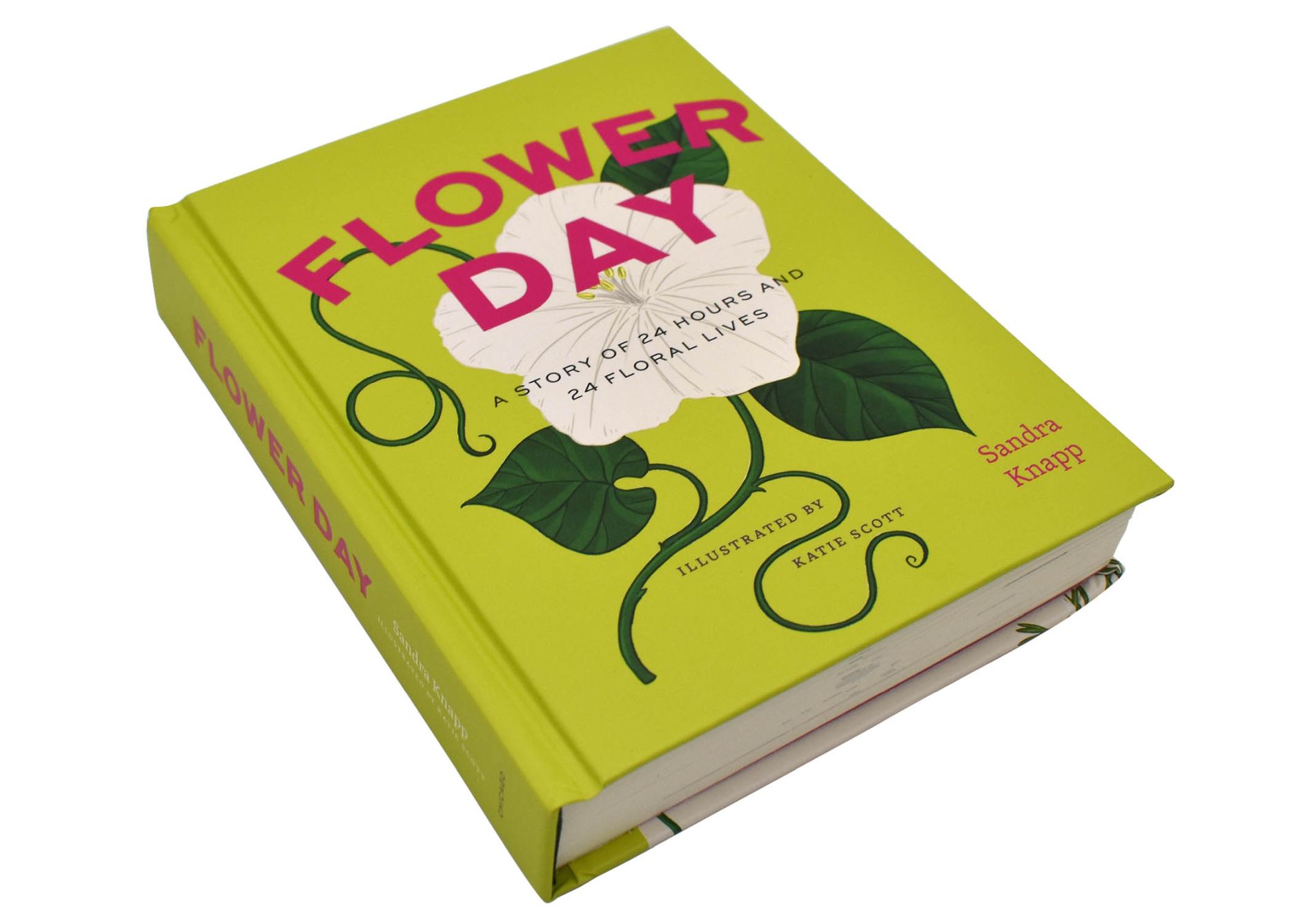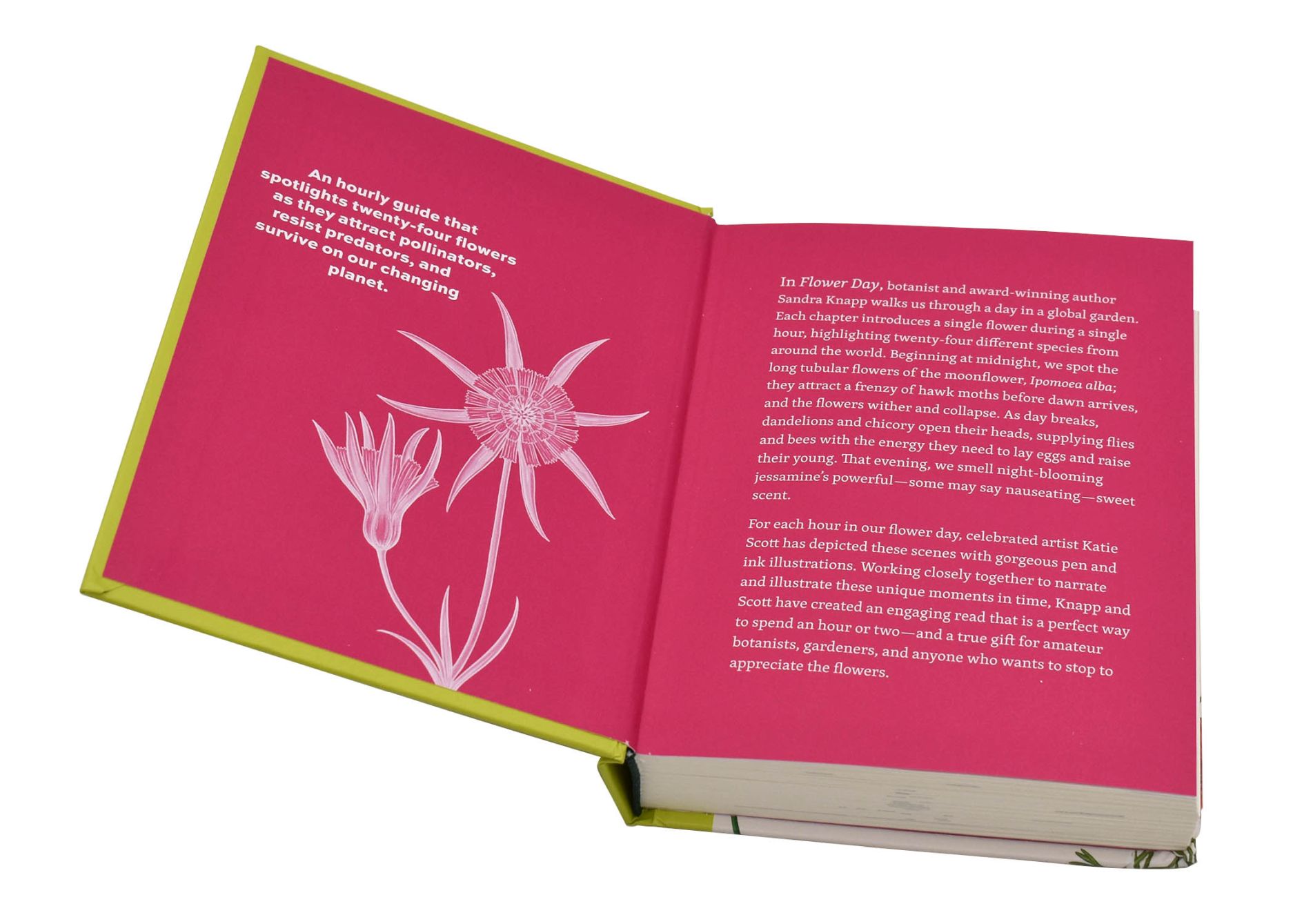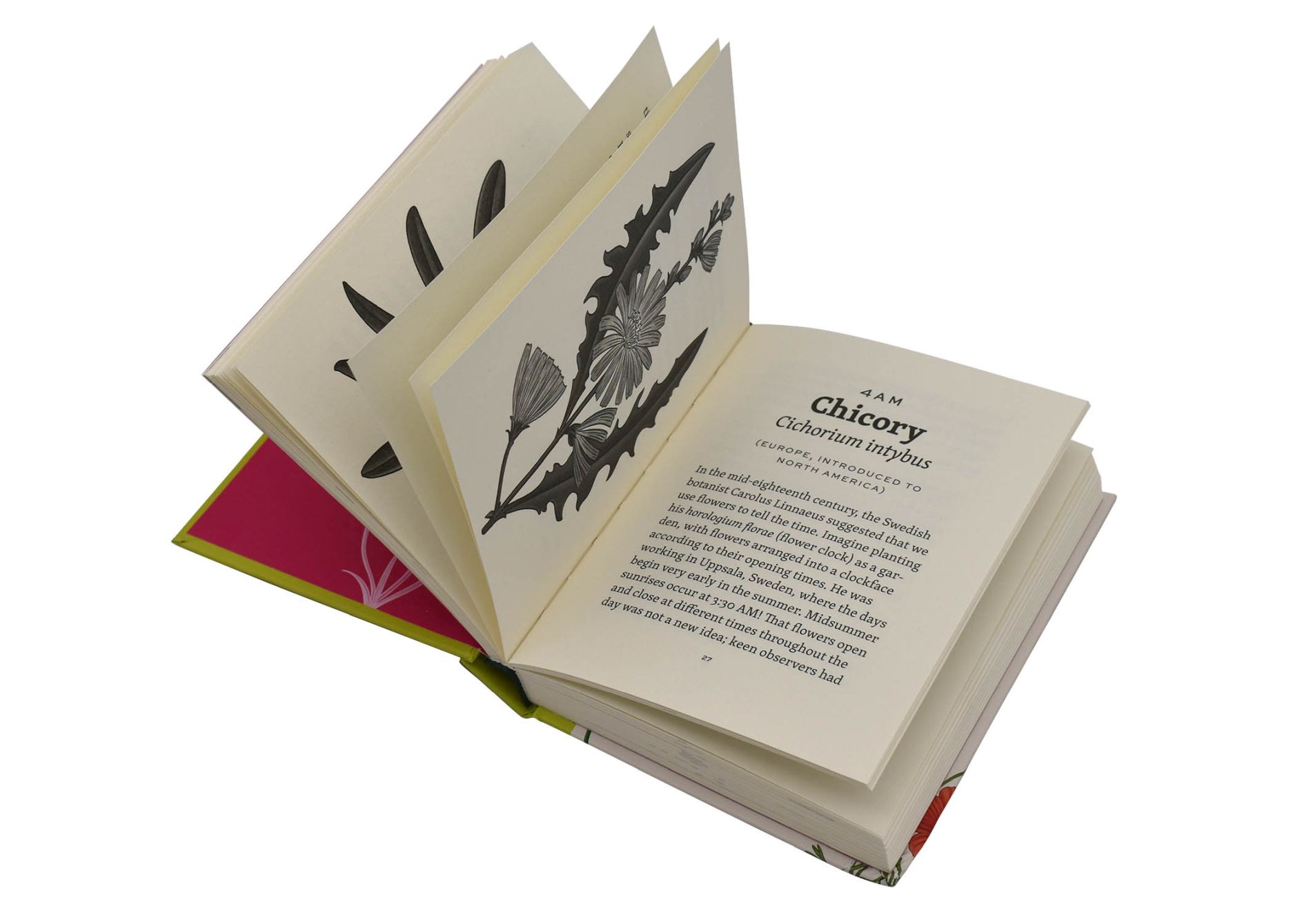Flower Day
A Story of 24 Hours and 24 Floral Lives
An illustrated hourly guide that spotlights twenty-four flowers as they attract pollinators, resist predators, and survive on our changing planet.
Is it 4 AM or chicory o’clock? In this short book, botanist and award-winning author Sandra Knapp walks us through a day in a global garden. Each chapter of Flower Day introduces a single flower during a single hour, highlighting twenty-four different species from around the world.
Beginning at midnight in the Americas, we spot the long tubular flowers of the moonflower, Ipomoea alba; they attract a frenzy of hawk moths before the dawn arrives and the flowers wither and collapse. As day breaks, dandelions and chicory open their heads—actually made up of many individual flowers tightly packed together—and flies and bees visit to get the energy they need to lay eggs and raise their young. Later, at eight o’clock in the morning, the sun rises over the watery Amazon basin, and we meet the giant waterlily, slowly turning from white to pink and purple. Trapped inside are the beetles who feasted on the flowers during the night. That evening, at seven o’clock, we travel to the Caribbean to smell night-blooming jessamine’s powerful—some may say nauseating—sweet scent. But this member of the nightshade family isn’t just a thing of beauty—it has a reputation as both a poison and invasive species, crowding out endangered native trees.
For each hour in our flower day, celebrated artist Katie Scott has depicted these scenes with gorgeous pen-and-ink illustrations. Working closely together to narrate and illustrate these unique moments in time, Knapp and Scott have created an engaging read that is a perfect way to spend an hour or two—and a true gift for amateur botanists, gardeners, and anyone who wants to stop and appreciate the flowers.
Is it 4 AM or chicory o’clock? In this short book, botanist and award-winning author Sandra Knapp walks us through a day in a global garden. Each chapter of Flower Day introduces a single flower during a single hour, highlighting twenty-four different species from around the world.
Beginning at midnight in the Americas, we spot the long tubular flowers of the moonflower, Ipomoea alba; they attract a frenzy of hawk moths before the dawn arrives and the flowers wither and collapse. As day breaks, dandelions and chicory open their heads—actually made up of many individual flowers tightly packed together—and flies and bees visit to get the energy they need to lay eggs and raise their young. Later, at eight o’clock in the morning, the sun rises over the watery Amazon basin, and we meet the giant waterlily, slowly turning from white to pink and purple. Trapped inside are the beetles who feasted on the flowers during the night. That evening, at seven o’clock, we travel to the Caribbean to smell night-blooming jessamine’s powerful—some may say nauseating—sweet scent. But this member of the nightshade family isn’t just a thing of beauty—it has a reputation as both a poison and invasive species, crowding out endangered native trees.
For each hour in our flower day, celebrated artist Katie Scott has depicted these scenes with gorgeous pen-and-ink illustrations. Working closely together to narrate and illustrate these unique moments in time, Knapp and Scott have created an engaging read that is a perfect way to spend an hour or two—and a true gift for amateur botanists, gardeners, and anyone who wants to stop and appreciate the flowers.
Reviews
Table of Contents
Preface
Midnight Moonflower (The Americas)
1 AM Queen of the Night (The Caribbean, Central America, Mexico)
2 AM Angraecum (Madagascar)
3 AM East Coast Banksia (Australia)
4 AM Chicory (Europe, Introduced to North America)
5 AM Dandelion (Worldwide)
6 AM Coyote Tobacco (North America)
7 AM Curly Rock Rose (Africa, Europe)
8 AM Uape Jacana or Giant Waterlily (Amazon Basin, the Guianas)
9 AM Sunflower (North America)
10 AM Sago Palm (Southeast Asia)
11 AM Western Blue Flax or Lewis Flax (North America)
Noon Jack-Go-to-Bed-at-Noon or Meadow Salsify (Europe, Introduced to North America)
1 PM Antarctic Hair Grass (Antarctica, Patagonia)
2 PM Titan Arum or Corpse Flower (Sumatra)
3 PM The Traveler’s Tree (Madagascar)
4 PM Four-O’Clock (The Americas)
5 PM Harakeke or New Zealand Flax (Aotearoa—New Zealand)
6 PM California Poppy (North America)
7 PM Night-Blooming Jessamine (The Caribbean)
8 PM White Campion (Eurasia, Introduced to North America)
9 PM Sacred Datura (North America)
10 PM Leafless Ephedra (Europe)
11 PM Giant Saguaro (North America)
Epilogue
Acknowledgments
Further Reading
Index
Midnight Moonflower (The Americas)
1 AM Queen of the Night (The Caribbean, Central America, Mexico)
2 AM Angraecum (Madagascar)
3 AM East Coast Banksia (Australia)
4 AM Chicory (Europe, Introduced to North America)
5 AM Dandelion (Worldwide)
6 AM Coyote Tobacco (North America)
7 AM Curly Rock Rose (Africa, Europe)
8 AM Uape Jacana or Giant Waterlily (Amazon Basin, the Guianas)
9 AM Sunflower (North America)
10 AM Sago Palm (Southeast Asia)
11 AM Western Blue Flax or Lewis Flax (North America)
Noon Jack-Go-to-Bed-at-Noon or Meadow Salsify (Europe, Introduced to North America)
1 PM Antarctic Hair Grass (Antarctica, Patagonia)
2 PM Titan Arum or Corpse Flower (Sumatra)
3 PM The Traveler’s Tree (Madagascar)
4 PM Four-O’Clock (The Americas)
5 PM Harakeke or New Zealand Flax (Aotearoa—New Zealand)
6 PM California Poppy (North America)
7 PM Night-Blooming Jessamine (The Caribbean)
8 PM White Campion (Eurasia, Introduced to North America)
9 PM Sacred Datura (North America)
10 PM Leafless Ephedra (Europe)
11 PM Giant Saguaro (North America)
Epilogue
Acknowledgments
Further Reading
Index



